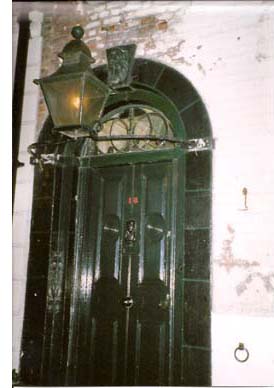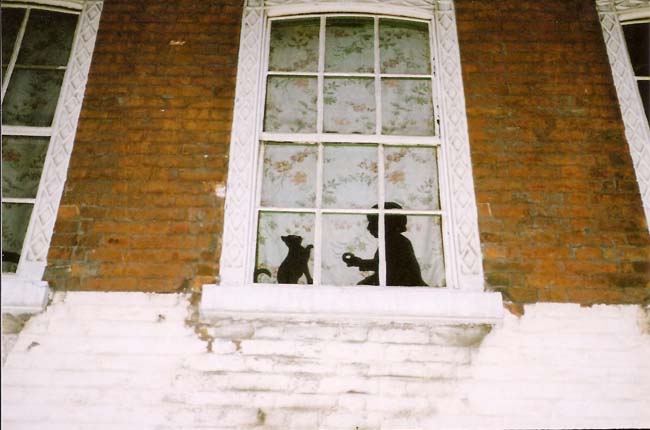Dennis Severs' House: Capturing an Imaginary Moment in Time
by Grant Eustace
 'Unique' is a description that is applied widely to
historic buildings in London that have survived into our own day.
To those that stretch back to the Middle Ages and beyond, for
example, like Westminster Hall and Westminster Abbey. Or the
remarkable clutch of highly-individual churches that Sir
Christopher Wren built after the Great Fire of 1666, culminating
in that towering work of genius, St Paul's Cathedral. 'Unique' is a description that is applied widely to
historic buildings in London that have survived into our own day.
To those that stretch back to the Middle Ages and beyond, for
example, like Westminster Hall and Westminster Abbey. Or the
remarkable clutch of highly-individual churches that Sir
Christopher Wren built after the Great Fire of 1666, culminating
in that towering work of genius, St Paul's Cathedral.
The word is equally applicable to less grand structures, like the
17th century timber-framed buildings in the Strand opposite the
Law Courts, and the Georgian town houses all over London that are
distinctive for the blue plaques on their walls telling of the
famous person who lived there.
But sometimes it can be a struggle to recapture more than
fleetingly the spirit of those buildings' times. Outside it can
be because of the continual noise of traffic, and inside the
throng of tourists. Or because the 21st century intrudes: signs
and fire exits in the big visitor attractions, or modern
decoration glimpsed through the clear glass windows of period
homes that are still privately owned.
But there is one London building that not only consciously sets
out to retain the flavour of a past era, but does so by making it
seem as if you have entered that era and interrupted those
actually living in it. Candles lit. Fires burning in the
grates. Food, from baked potatoes to boiled eggs, half-eaten.
Beds unmade. Evencsuch attention to detail -- a chamber-pot not
yet emptied. In that respect Dennis Severs' House, too, is
unique.
It is a terraced Georgian house in Folgate Street, London E1.
That is one of the many short and often narrow streets that lie
just to the east of Liverpool Street Station, in the area known
as Spitalfields. Given that location, the house is unusual,
anyway, in having survived to the present. Perhaps developers,
who have been frantically busy all around it, could be kept at
bay because of the intrinsic importance of a building from the
18th century. But the bombs in the Second World War did not
discriminate, and this was an area hit hard and often.
Dennis Severs was an artist who, somewhat eccentrically, enjoyed
living in the house much as its original occupants would have
done. From that developed the idea of letting others enjoy the
atmosphere in the way that he did, in what he called 'Still Life
Drama' -- as if you could walk through into a painting. The
basic idea is to stimulate the visitor's senses, so that his or
her imagination supplies what is not there.
There is a good deal there, of course, in ten rooms across five
floors. And each of the rooms is cluttered to the point of
claustrophobia with essentials and some collectables as well.
That begins in the packed cellar kitchen, reached down the
original wooden stair that clearly pre-dates any concept of
building regulations about safety, and with a ceiling so low that
anyone of six foot is stooping.
The majority of the rooms recall the same 18th-century period.
They include a smoking room modelled on the scene in the Hogarth
painting on the wall of a drinking bout, right down to the
overturned bottle and spilled wine. There is a withdrawing room
for more genteel behaviour, an eating parlour, and bedrooms whose
most abiding impression is again of how much is packed into the
limited space.
The top floor, though, comes forward in time, preserved as the
19th-century home of lodgers, a poor, struggling family of
weavers whose workplace is the even more cramped loft space above
them. Here the flavour is strongly Dickensian (even to the Tiny
Tim-sized crutches beside the fire), and it is something of a
shock to realise that this is not the set of a film, but how it
really was: one room serving for an entire family.
To supplement the physical, there are smells -- of food in rooms
where there are meals being taken, for example, and scented
candles upstairs. And there is sound, such as the faint voice of
the master of the house instructing a servant, and the chirrup of
a caged bird. Most effective are the noises apparently outside
rooms facing the street of passing horse-drawn carriages, and the
servants' bell ringing in the cellar. (Especially if you are in
the cellar at the time, and do not know it is due to ring.)

So how effective is the illusion? Certainly actors preparing
for a period role have been known to sit in the House and soak up
the 'vibrations'. There they have some advantage on the rest of
us, though, since they do so on their own. The House rule is
silence, but even in a small group there is usually someone who
cannot resist a comment, and a whisper can be enough to break the
spell. Your own movement, too, on the creaky floors, does not
help.
But it is nevertheless an experience like no other. This is
because of the way the House is frozen at a moment in the past --
but not as a museum house in the usual sense, with everything
prettified and tidy. The essential difference here is that strong
feeling of a house being lived in. It is just that the people
are not there.
Above all, it brings home the scarcely tolerable lack of space
and privacy that was the norm for the occupants of a house such
as this, and the many more like it. And if you are there at
night -- Dennis Severs' House is open only at certain specific
times -- you can only wonder at the difference, the pools of
darkness and the shadows, when your sole source of interior light
is candles.
'Time-capsule' is another of those over-used words. But it
definitely does feel, when you emerge back into Folgate Street,
as if you are returning to your own time after a real visit to
another era.
More Information:
We regret that we no longer have the resources to maintain up-to-date links and/or hours and pricing details for the various sites and attractions listed on this website. For more information about the location(s) listed above, please use your favorite search engine or visit Wikipedia.
Grant Eustace is a professional writer active in a
variety of fields, from film and video through print to radio
and on-line content, the last two of these principally for the
BBC World Service. He also works with -- and speaks regularly at
international gatherings of -- the Tourism and Cultural Identity
Committee of the World Trade Centers Association.
Article and photos © 2008 Grant Eustace
| 